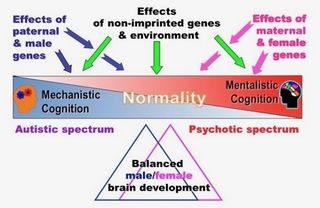Gender
A Diametric Diagnosis of the New British Disease
Institutionalized gender dysphoria can be explained by the diametric model.
Posted September 25, 2019
A major virtue of the diametric model of mental illness is that it can be applied to groups, institutions, and even entire societies—at least if you concede that each can be seen to have a characteristic configuration on the continuum of mentalistic versus mechanistic cognition (below).

I discuss this in relation to Western civilization at length in The Diametric Mind, but here I simply wish to comment on a searing indictment of what you might call (borrowing a phrase from an earlier period of journalism) the "British Disease" by the journalist, Celia Walden.
In a previous post, I argued that modern Western societies—and perhaps Britain in particular—can be seen as “autistic”. One particular aspect on which Walden touches, LGBT-ism, also fits the picture if you see it as a cultural manifestation of the gender dysphoria often associated with high-functioning autism (and probably explicable in terms of the lingering Lyonization effect I explained in earlier posts).
But a quick glance at the diagram at the top reveals that, although normality can be defined in diametric terms as balanced between the extremes of autism and psychosis, the fact that all fathers are male and that all mothers are female also implies that not just parental, but specifically male and female genes are also implicated in determining that the point of balance for each sex is slightly offset: the male on the autistic side and female on the psychotic. Furthermore, this could explain a lot, not just about individual but social psychopathology, too.
As one of the world’s most famous autistics, Temple Grandin, has pointed out (see reference), Western societies of the recent past may have made life easier for high-functioning autistics than do present-day ones. The explanation may simply be that in the past it was much more of a man’s world than is the case today, and given that autism has been associated since Asperger with male mentality, past Western societies were, therefore, more mechanistic—and certainly more typically male—in their cognitive configuration.
This is at least in the public sphere, if not necessarily so in the domestic one. In a world with a male-breadwinner/female home-maker division of labour institutionalized in the convention that only single women worked outside the home, autistics—particularly high-functioning ones—might seem much less out of place, especially if, as is indeed the case, the majority of them were themselves male as Asperger noticed from the beginning.
But since the World Wars, and especially World War 2, Western societies have seen the full emancipation of women, not simply in terms of getting the vote, but in getting control of their own fecundity thanks to efficient contraception and safe abortion, and thereby levelling the playing field where competition for jobs, employment, and remuneration with men were concerned. Indeed, today, this trend has reached its apogee, with women coming to occupy a prominent place in many occupations and professions: notably medicine (especially general practice); law; psychotherapy; journalism, editing, and public relations; and increasingly in politics, public administration, and government.
The result has been that the cognitive configuration of Western civilization as a whole has shifted from being centered on the male point of balance illustrated above to being based on the female one. But as the diagram also reveals, the migration towards the female side is also inevitably one towards hyper-mentalism and even psychosis.
The British led the world into the modern industrial era, and so it is perhaps not surprising that they may now be seen to have over-reacted in the opposite direction, not only in de-industrializing (what used to be called the British Disease) but in contracting the new version so wittily portrayed by Celia Waldon. At the very least, you could see what she describes as a result of our current leaders' use of only half of their brains, as I suggested in a recent post.
And as the diagram at the top also clearly shows, a society with genuine gender equality would have a collective point of balance exactly halfway between the male and female points indicated. Let's hope we get there in the end.
References
Grandin, T. and S. Barron, The Unwritten Rules of Social Relationships. 2005, Arlington TX: Future Horizons Inc. pp. 3, 5.
For more on this, see my final project on ResearchGate at: https://www.researchgate.net/project/The-Menace-of-Mentalism


